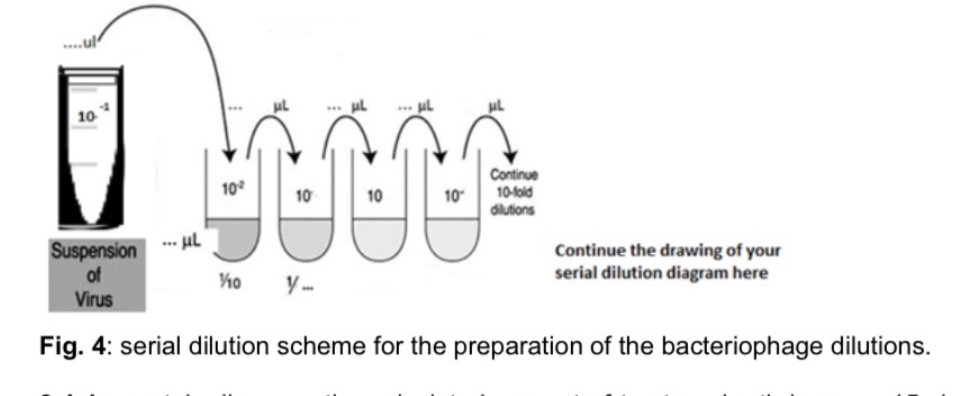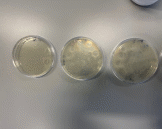Introduction
Experiment to determine the number of infective phage particles in a sample using viral titration.
Methods/Procedure

The peculiarities of bacteriophage reproduction are related to their intensive expansion during cultivation, so a procedure of sequential tenfold dilution was used (Figure 1): a total of nine test tubes with molten tryptone-soft agar. A 200 mL aliquot of E.coli was added to each of the tubes, and after thorough mixing in a water bath, the samples were transferred to prelabeled plates.

Results
Since the basis of the experiment was to measure the number of plaques on previously prepared plates, the only direct measurement was to count the number of such spots on the entire plate, and only the minimum final concentrations were used to ensure reliability. The second column of Table 1 below reflects the counted quantities, with the third column giving the relative plaque content per unit volume (mL).
Table 1. Results of absolute and relative plaque counts.
Discussion/Conclusion
The purpose of the present study was to use a plaque quantification protocol to determine the active bacteriophage units in the samples. Bacteriophages are typical viruses whose mechanism of infection is directed purely at bacteria, which means that bacteria are directly targeted by bacteriophages (Hill, 2019). The release of cellular material by bacteriophages occurs through a complex procedure of lysis of the bacterial cell wall, injection of genetic material, and subsequent stages of transcription and translation of recombinant proteins (Principi et al., 2019). All this is not aimed at destroying the bacterial cell but at creating another farm for autonomous viral reproduction.
There are a vast number of bacteria in the human body, many of which are symbionts. One of these is E. coli, a symbiotic bacterium of the intestinal system that helps process complex carbohydrates (E. coli, 2018). Obviously, E. coli can be susceptible to the deleterious effects of bacteriophages. There is a separate cluster of such viruses, Coliphages, whose action targets E. coli directly (Pacífico et al., 2019). As a consequence, disruption of the viability of symbiotic bacteria, as an example, affects the health of the individual and brings deterioration of the quality of life.
A plaque counting procedure on bacteriophage growth plates is used for titrimetric microbiological analysis tasks. Plaques are to be understood as spot-like formations in which active growth of the pathogen is observed. For those cases where the concentrations of the agar medium are known, it becomes possible to determine the predicted content of the virus particles in the initial solution, which was demonstrated in this experiment. In fact, it should be clarified that the use of the PFU (or PFU/ml) measure is an analogous measure for colony forming units (CFU) for bacteria, which means that a parallel can be drawn between the two concepts (How to calculate CFU, 2019). PFU is thus used to quantify the viable bacteriophages that can reproduce in this agar. It is worth emphasizing, however, that PFU does not measure the absolute number of viral particles in the agar but rather only those that are viable and can form plaques.
Reference List
E. coli (2018) Web.
Hill, C. (2019) Bacteriophages: Viruses that infect bacteria. Web.
How to calculate CFU (colony forming unit) (2019) Web.
Pacífico, C., Hilbert, M., Sofka, D., Dinhopl, N., Pap, I.J., Aspöck, C., Carriço, J.A. and Hilbert, F. (2019) ‘Natural occurrence of Escherichia coli-infecting bacteriophages in clinical samples,’ Frontiers in Microbiology, pp. 2484-2490.
Principi, N., Silvestri, E. and Esposito, S. (2019) ‘Advantages and limitations of bacteriophages for the treatment of bacterial infections,’ Frontiers in Pharmacology, 10, pp. 513-518.